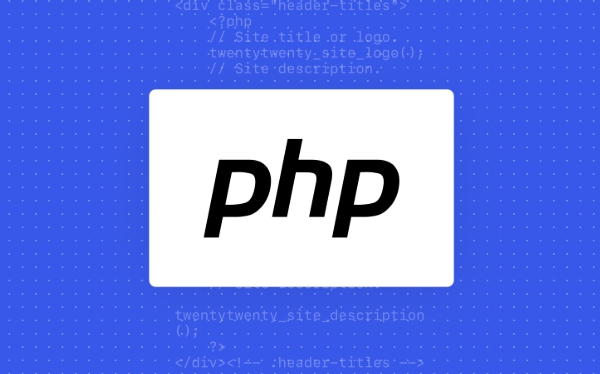The method to verify whether a string is legal in PHP is to use json_decode to judge the parsing result with json_last_error. The specific steps are as follows: 1. Use json_decode to try parsing the string; 2. Check whether there is an error through json_last_error. If you return JSON_ERROR_NONE, it means that it is legal; 3. For empty strings or simple values such as "null", you need to judge the type according to business needs; 4. If the expected result is an array, you can add is_array verification; 5. When processing unreliable input, it is recommended to use trim to remove the whitespace, and note that single quotes should be replaced with double quotes.

Sometimes you get a string, not sure if it is a legitimate JSON format, especially when dealing with API interfaces or user input. In PHP, there are actually relatively simple and reliable ways to verify this.

Use json_decode to judge
The json_decode function that comes with PHP can try to parse whether a string is legal JSON. If parsing fails, it means that the string is not a valid JSON.
You can write this way:

function is_valid_json($string) {
json_decode($string);
return json_last_error() === JSON_ERROR_NONE;
} The core of this method is: first try parsing with json_decode , and then check whether there are errors through json_last_error() . If there is no error, it means it is a legal JSON.
Some common mistakes include:

-
JSON_ERROR_SYNTAX: Syntax errors, such as mismatch in brackets, unclosed quotes, etc. -
JSON_ERROR_UTF8: Encoding issues, such as strings containing illegal UTF-8 characters.
Pay attention to handling null values and arrays
Sometimes, json_decode can successfully parse even an empty string, or a simple value like "null" or "true" , but it may not meet your business needs.
for example:
- An empty string
""will be considered not a legitimate JSON. - The string
"null"is a legal JSON value. - If you want to make sure it is an object or array, you also need to judge the type additionally.
So if you want this JSON to end up being an array or object, you can add the type to judge:
function is_valid_json_and_assoc($string) {
$result = json_decode($string, true);
return json_last_error() === JSON_ERROR_NONE && is_array($result);
}This ensures that the parsed result is an array (rather than a scalar value or other types).
Tips for handling original input
When the data source you want to check is unreliable, such as from user submissions or third-party interfaces, it is recommended to do basic filtering first, such as removing the beginning and end blank characters:
$string = trim($string);
Because sometimes extra spaces or newlines can cause parsing to fail, and these characters themselves do not affect the content of JSON.
Another small detail is: if the input looks like JSON, but uses single quotes, such as '{"name": "John"}' , this format will also be considered illegal by json_decode in PHP. At this time, you need to replace the single quotes with double quotes in advance, or prompt the user to correct the format.
Basically that's it. Just remember that the core method is json_decode json_last_error , and the rest are supplementary judgments based on actual scenarios.
The above is the detailed content of How to check if a string is valid JSON in PHP. For more information, please follow other related articles on the PHP Chinese website!

Hot AI Tools

Undress AI Tool
Undress images for free

Undresser.AI Undress
AI-powered app for creating realistic nude photos

AI Clothes Remover
Online AI tool for removing clothes from photos.

Clothoff.io
AI clothes remover

Video Face Swap
Swap faces in any video effortlessly with our completely free AI face swap tool!

Hot Article

Hot Tools

Notepad++7.3.1
Easy-to-use and free code editor

SublimeText3 Chinese version
Chinese version, very easy to use

Zend Studio 13.0.1
Powerful PHP integrated development environment

Dreamweaver CS6
Visual web development tools

SublimeText3 Mac version
God-level code editing software (SublimeText3)

Hot Topics
 What are some best practices for versioning a PHP-based API?
Jun 14, 2025 am 12:27 AM
What are some best practices for versioning a PHP-based API?
Jun 14, 2025 am 12:27 AM
ToversionaPHP-basedAPIeffectively,useURL-basedversioningforclarityandeaseofrouting,separateversionedcodetoavoidconflicts,deprecateoldversionswithclearcommunication,andconsidercustomheadersonlywhennecessary.StartbyplacingtheversionintheURL(e.g.,/api/v
 How do I implement authentication and authorization in PHP?
Jun 20, 2025 am 01:03 AM
How do I implement authentication and authorization in PHP?
Jun 20, 2025 am 01:03 AM
TosecurelyhandleauthenticationandauthorizationinPHP,followthesesteps:1.Alwayshashpasswordswithpassword_hash()andverifyusingpassword_verify(),usepreparedstatementstopreventSQLinjection,andstoreuserdatain$_SESSIONafterlogin.2.Implementrole-basedaccessc
 What are weak references (WeakMap) in PHP, and when might they be useful?
Jun 14, 2025 am 12:25 AM
What are weak references (WeakMap) in PHP, and when might they be useful?
Jun 14, 2025 am 12:25 AM
PHPdoesnothaveabuilt-inWeakMapbutoffersWeakReferenceforsimilarfunctionality.1.WeakReferenceallowsholdingreferenceswithoutpreventinggarbagecollection.2.Itisusefulforcaching,eventlisteners,andmetadatawithoutaffectingobjectlifecycles.3.YoucansimulateaWe
 What are the differences between procedural and object-oriented programming paradigms in PHP?
Jun 14, 2025 am 12:25 AM
What are the differences between procedural and object-oriented programming paradigms in PHP?
Jun 14, 2025 am 12:25 AM
Proceduralandobject-orientedprogramming(OOP)inPHPdiffersignificantlyinstructure,reusability,anddatahandling.1.Proceduralprogrammingusesfunctionsorganizedsequentially,suitableforsmallscripts.2.OOPorganizescodeintoclassesandobjects,modelingreal-worlden
 How can you handle file uploads securely in PHP?
Jun 19, 2025 am 01:05 AM
How can you handle file uploads securely in PHP?
Jun 19, 2025 am 01:05 AM
To safely handle file uploads in PHP, the core is to verify file types, rename files, and restrict permissions. 1. Use finfo_file() to check the real MIME type, and only specific types such as image/jpeg are allowed; 2. Use uniqid() to generate random file names and store them in non-Web root directory; 3. Limit file size through php.ini and HTML forms, and set directory permissions to 0755; 4. Use ClamAV to scan malware to enhance security. These steps effectively prevent security vulnerabilities and ensure that the file upload process is safe and reliable.
 What are the differences between == (loose comparison) and === (strict comparison) in PHP?
Jun 19, 2025 am 01:07 AM
What are the differences between == (loose comparison) and === (strict comparison) in PHP?
Jun 19, 2025 am 01:07 AM
In PHP, the main difference between == and == is the strictness of type checking. ==Type conversion will be performed before comparison, for example, 5=="5" returns true, and ===Request that the value and type are the same before true will be returned, for example, 5==="5" returns false. In usage scenarios, === is more secure and should be used first, and == is only used when type conversion is required.
 How can you interact with NoSQL databases (e.g., MongoDB, Redis) from PHP?
Jun 19, 2025 am 01:07 AM
How can you interact with NoSQL databases (e.g., MongoDB, Redis) from PHP?
Jun 19, 2025 am 01:07 AM
Yes, PHP can interact with NoSQL databases like MongoDB and Redis through specific extensions or libraries. First, use the MongoDBPHP driver (installed through PECL or Composer) to create client instances and operate databases and collections, supporting insertion, query, aggregation and other operations; second, use the Predis library or phpredis extension to connect to Redis, perform key-value settings and acquisitions, and recommend phpredis for high-performance scenarios, while Predis is convenient for rapid deployment; both are suitable for production environments and are well-documented.
 How do I perform arithmetic operations in PHP ( , -, *, /, %)?
Jun 19, 2025 pm 05:13 PM
How do I perform arithmetic operations in PHP ( , -, *, /, %)?
Jun 19, 2025 pm 05:13 PM
The methods of using basic mathematical operations in PHP are as follows: 1. Addition signs support integers and floating-point numbers, and can also be used for variables. String numbers will be automatically converted but not recommended to dependencies; 2. Subtraction signs use - signs, variables are the same, and type conversion is also applicable; 3. Multiplication signs use * signs, which are suitable for numbers and similar strings; 4. Division uses / signs, which need to avoid dividing by zero, and note that the result may be floating-point numbers; 5. Taking the modulus signs can be used to judge odd and even numbers, and when processing negative numbers, the remainder signs are consistent with the dividend. The key to using these operators correctly is to ensure that the data types are clear and the boundary situation is handled well.






